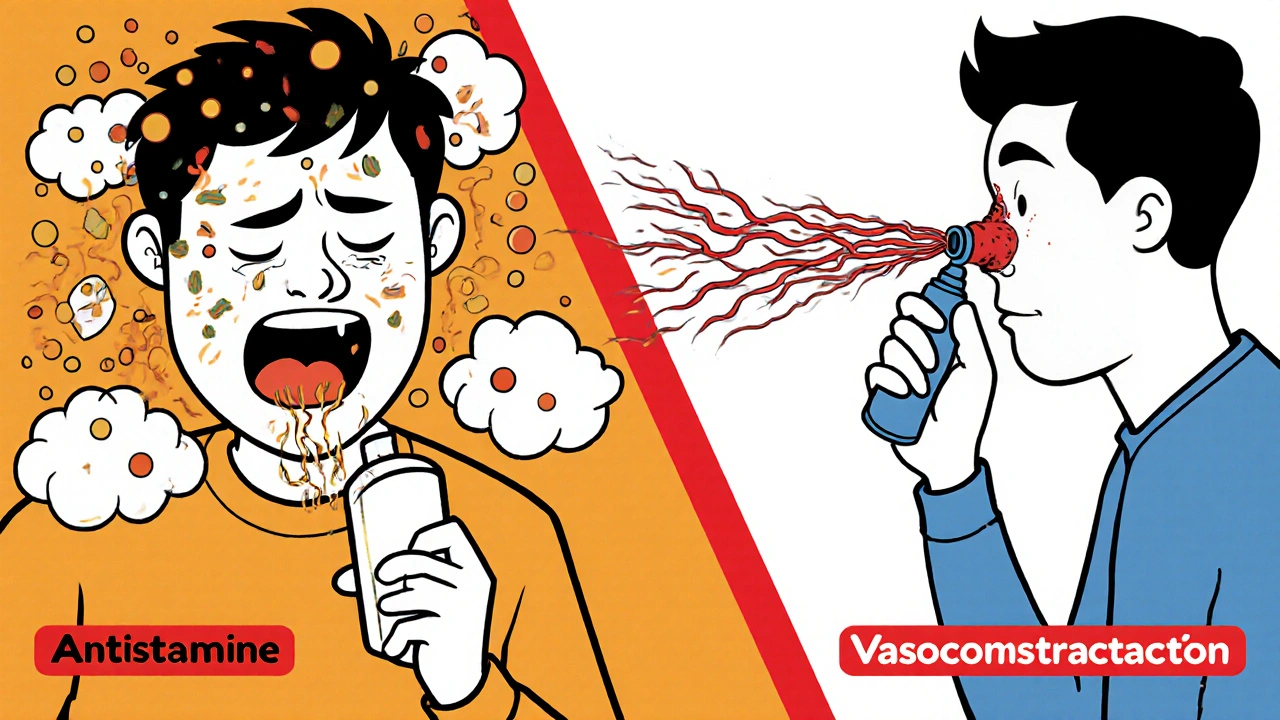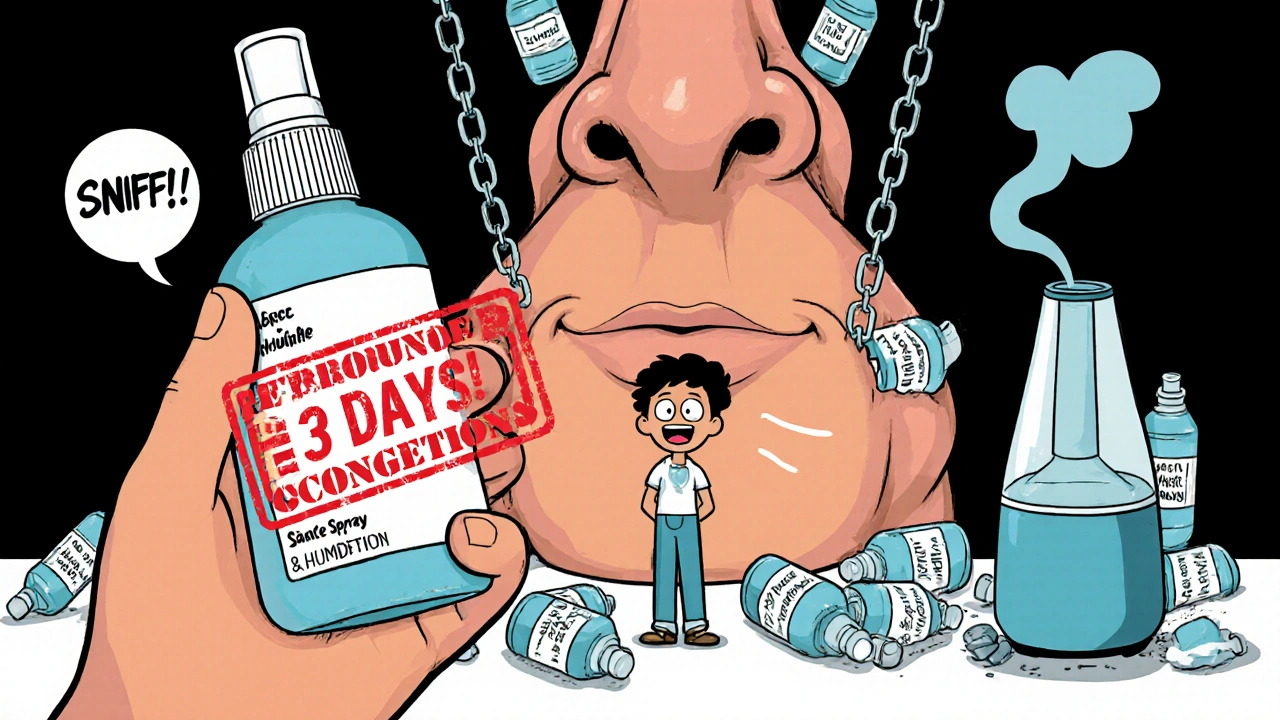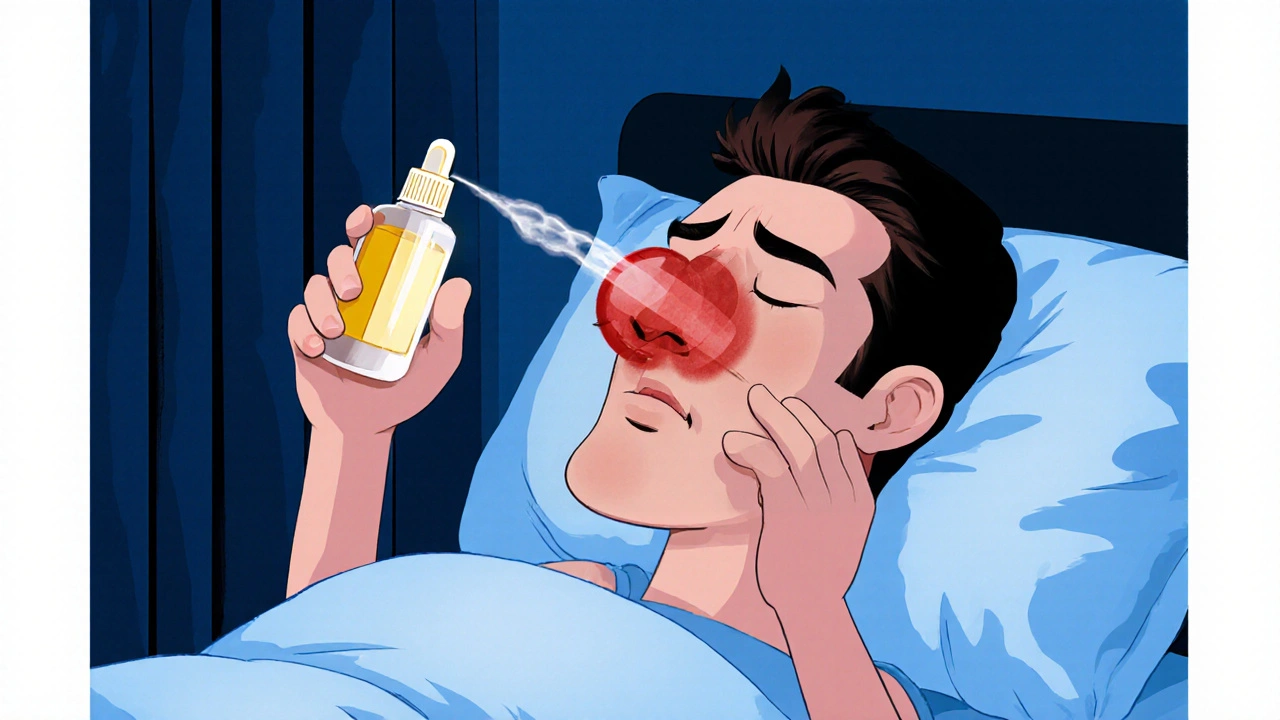When your nose is completely blocked and you can’t breathe through it, even simple tasks like sleeping or talking feel impossible. For millions of people with seasonal allergies or chronic nasal congestion, oxymetazoline hydrochloride is the go-to solution that works in minutes. It’s not an antihistamine. It doesn’t stop sneezing or itching. But if your main problem is a stuffed-up nose, this ingredient is one of the most effective tools you can find over the counter.
What Oxymetazoline Hydrochloride Actually Does
Oxymetazoline hydrochloride is a nasal decongestant. It’s the active ingredient in brands like Afrin, Dristan, and Vicks Sinex. Unlike antihistamines that block histamine (the chemical your body releases during an allergic reaction), oxymetazoline works directly on the blood vessels inside your nasal passages.
When you have allergies, your nasal tissues swell up because blood vessels expand. This swelling blocks airflow. Oxymetazoline tightens those blood vessels - a process called vasoconstriction. As the vessels shrink, the swelling goes down, and air flows more freely. You can feel the difference in as little as 15 to 30 seconds after spraying.
This isn’t magic. It’s physics. The drug binds to alpha-adrenergic receptors on the smooth muscle around blood vessels. That triggers contraction. Less blood flow to the swollen tissue = less swelling = clearer nose. It’s targeted, fast, and powerful - which is why it works so well.
When to Use It - and When Not To
Oxymetazoline hydrochloride is ideal for short-term relief. If you’ve got a sudden allergy flare-up from pollen, dust, or pet dander, and your nose is closed off, a single spray can make a real difference. It’s especially helpful before bedtime, during meetings, or while traveling.
But here’s the catch: it’s not meant for daily, long-term use. Using it for more than three days in a row can cause rebound congestion - also called rhinitis medicamentosa. That’s when your nasal passages become dependent on the spray. Once you stop, the swelling comes back worse than before. You end up needing more spray just to feel normal. It’s a vicious cycle many people don’t realize they’re in until they’re stuck.
People with high blood pressure, heart disease, or thyroid problems should talk to a doctor before using it. Oxymetazoline can raise blood pressure slightly and speed up your heart rate. It’s also not recommended for children under six without medical advice.
How It Compares to Other Allergy Treatments
Many people mix up decongestants and antihistamines. They think all allergy meds are the same. They’re not.
Antihistamines like loratadine (Claritin) or cetirizine (Zyrtec) work on the root cause - they block histamine. That helps with sneezing, itchy eyes, and runny nose. But they don’t do much for a completely blocked nose. That’s where oxymetazoline fills the gap.
Here’s how they stack up:
| Treatment Type | How It Works | Onset Time | Duration | Best For | Risk of Rebound |
|---|---|---|---|---|---|
| Oxymetazoline Hydrochloride | Constricts nasal blood vessels | 15-30 seconds | 8-12 hours | Severe nasal congestion | High if used >3 days |
| Loratadine (Claritin) | Blocks histamine | 1-3 hours | 24 hours | Sneezing, runny nose, itchy eyes | None |
| Corticosteroid Nasal Sprays (Flonase) | Reduces inflammation | 1-2 days | 24 hours | Chronic allergies, persistent congestion | Very low |
| Pseudoephedrine (Sudafed) | Systemic decongestant | 30-60 minutes | 4-6 hours | General congestion, sinus pressure | Low |
Flonase and other steroid sprays are better for long-term allergy control. But they take days to build up effectiveness. If you need relief now, oxymetazoline wins. Pseudoephedrine works systemically - it helps your whole nasal passage, but it can cause jitteriness or trouble sleeping. Oxymetazoline stays local. Less body-wide side effects, but more risk of rebound if misused.

How to Use It Correctly
Using oxymetazoline wrong is how people get stuck in rebound congestion. Here’s how to use it safely:
- Blow your nose gently before spraying - clear out mucus so the spray reaches the tissue.
- Shake the bottle well.
- Tilt your head forward slightly, not back. This keeps the spray from dripping down your throat.
- Insert the nozzle just inside the nostril - don’t push it deep.
- Breathe in gently through your nose as you press the pump. One spray per nostril is enough.
- Wait a few seconds before blowing your nose again.
- Never use more than two sprays per nostril in 24 hours.
- Stop after three days, even if you still feel blocked.
Don’t share your spray. The nozzle can carry bacteria. And don’t store it in extreme heat - the formula can break down.
What Happens When You Overuse It
Rebound congestion isn’t just uncomfortable - it’s misleading. People think their allergies are getting worse. But it’s not the allergy. It’s the spray.
After three or four days of daily use, the blood vessels in your nose lose their ability to contract naturally. They become lazy. When you stop the spray, they swell up on their own, even without allergens. That’s when you feel like you’re stuck in a cycle: spray to feel better, then spray again because you feel worse without it.
Breaking the cycle takes discipline. You need to stop using oxymetazoline completely. The congestion will get worse for a few days - sometimes up to a week. It’s not dangerous, but it’s frustrating. To get through it, use saline sprays, humidifiers, and steam inhalation. Some doctors recommend a short course of oral steroids to help reduce swelling while your nose recovers.

Alternatives When You Can’t Use It
If you’ve had rebound congestion before, or if you’re pregnant, have high blood pressure, or just want to avoid chemicals altogether, there are safer options.
- Saline nasal sprays - wash out allergens and moisten tissue without any drugs. Safe for daily use, even for kids.
- Corticosteroid sprays - Flonase, Nasacort, Rhinocort. These reduce inflammation at the source. Take time to work, but they’re the gold standard for long-term allergy control.
- Neti pots - rinse your nasal passages with sterile salt water. Helps flush out pollen and mucus. Use distilled or boiled water only.
- Humidifiers - dry air makes congestion worse. Keeping the air moist helps your nasal lining stay healthy.
- Antihistamines - if your main issue is sneezing or watery eyes, these help more than decongestants.
Many people combine treatments. Use a steroid spray daily for prevention, and keep oxymetazoline on hand for sudden flare-ups - but only use it for one or two days at a time.
Real-Life Scenarios
Take Sarah, a teacher in Seattle. Every spring, ragweed pollen knocks her out. Her nose is blocked by noon. She used Afrin every day for two weeks last year. By March, she couldn’t go a day without it. She ended up in her doctor’s office with chronic congestion and a ringing in her ears. After stopping the spray and switching to Flonase and saline rinses, it took 10 days to feel normal again. Now she only uses oxymetazoline if she’s got a bad day - and never more than two sprays total.
Or James, a construction worker who’s allergic to dust. He uses a saline rinse every morning and keeps a single-use oxymetazoline spray in his toolbelt. He sprays once before a dusty job - just enough to breathe. He never uses it twice in a row. That’s smart use.
The difference? One person used it as a crutch. The other used it as a tool.
Final Takeaway
Oxymetazoline hydrochloride is a powerful, fast-acting tool for nasal congestion. But it’s not a cure. It’s a temporary fix. Used right, it gives you back your breathing. Used wrong, it steals it.
If your allergies are mild and occasional, try saline sprays and antihistamines first. If your nose is completely blocked and you need relief now, oxymetazoline works - but only for a day or two. Then switch to something safer. Your nose will thank you.
Can oxymetazoline hydrochloride cure allergies?
No. Oxymetazoline only treats nasal congestion - it doesn’t stop the allergic reaction itself. It doesn’t reduce sneezing, itching, or watery eyes. For long-term allergy control, you need antihistamines or corticosteroid sprays that target inflammation at the source.
Is oxymetazoline hydrochloride safe for children?
It’s not recommended for children under six without a doctor’s advice. Kids have smaller nasal passages, and the risk of side effects like increased heart rate or irritability is higher. For children, saline sprays and humidifiers are safer first choices.
How long does oxymetazoline hydrochloride stay in your system?
It doesn’t stay in your bloodstream for long. Most of it is absorbed locally in the nose and broken down within hours. But its effect on blood vessels lasts 8-12 hours. That’s why you only need to use it once or twice a day. It doesn’t accumulate in your body like some oral medications.
Can I use oxymetazoline with other allergy meds?
Yes, but carefully. You can safely combine it with antihistamines like Zyrtec or Claritin, or with corticosteroid sprays like Flonase. Just avoid other decongestants like pseudoephedrine - using multiple decongestants increases the risk of side effects like high blood pressure or rapid heartbeat.
What should I do if I’ve used oxymetazoline for more than 3 days?
Stop using it immediately. The congestion will likely get worse for 3-7 days as your nasal passages recover. Use saline sprays, a humidifier, and drink plenty of water. If symptoms don’t improve after a week, or if you have pain, fever, or green mucus, see a doctor - you might have a sinus infection.


All Comments
Mike Gordon October 31, 2025
Man, I used to be that guy who lived on Afrin like it was oxygen. Then one day I couldn’t breathe without it. Felt like my nose had turned into a traitor. Saline rinses and Flonase saved me. No more rebound hell. Just slow, steady relief. Don’t be me.
Kathy Pilkinton November 1, 2025
Oh wow. Another ‘decongestant is evil’ sermon. You people act like oxymetazoline is crack. It’s a tool. Use it right, it works. Use it wrong, you’re an idiot. Don’t blame the spray-blame the person who sprays it for 14 days straight. And no, I’m not sorry for being blunt.
Holly Dorger November 1, 2025
i read this whole thing and honestly? this is the most clear thing i’ve ever seen on nasal sprays. i had no idea rebound congestion was a thing. i thought my allergies were just getting worse. thanks for explaining the difference between antihistamines and decongestants. i’m switching to flonase now. also, neti pot is life. just use distilled water. please.
Amanda Nicolson November 2, 2025
Let me tell you about the time I used oxymetazoline for five days straight because I had a presentation and my nose was GONE. I thought I was being smart. I was not. I woke up day six feeling like my sinuses were filled with wet cement. I cried. I cried into a humidifier. I cried into a saline spray. It took seven days to feel normal again. Seven. Days. I learned my lesson. Don’t be a hero. Don’t be me. Use it once. Then walk away. Your nose has feelings too.
Jackson Olsen November 3, 2025
so if i use this for 2 days then stop i be fine right? no magic just physics? cool. i got a dusty job too. gonna keep a spray in my pocket. one puff max. thanks for the tips
Penny Clark November 3, 2025
omg this is so helpful 😭 i’ve been using Afrin for months and didn’t realize it was making it worse… i’m gonna try the saline rinse tonight and flonase tomorrow. thank you for writing this like a normal human who actually cares. 🙏
Niki Tiki November 4, 2025
Why are we coddling people who can't use a nasal spray right? America's gotten soft. Back in my day we just held our nose and breathed through our mouth. Now we need a 10-step guide and a lecture on vasculature. Use it. Don't use it. Stop whining. Your nose isn't a temple. It's a passage.
Jim Allen November 5, 2025
So oxymetazoline is basically the dopamine of nasal sprays. Quick hit. Instant relief. Then your brain says ‘more.’ But your nose says ‘no.’ Classic addiction cycle. We’re all just chasing temporary relief in a world that won’t stop making us sneeze. 🤷♂️💊